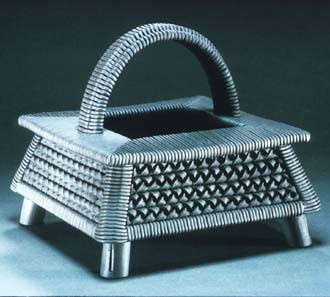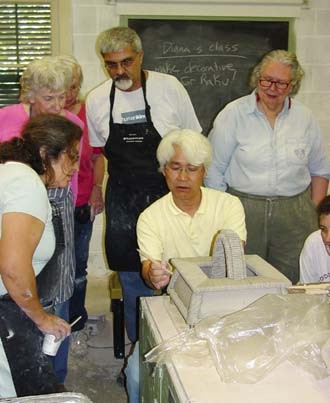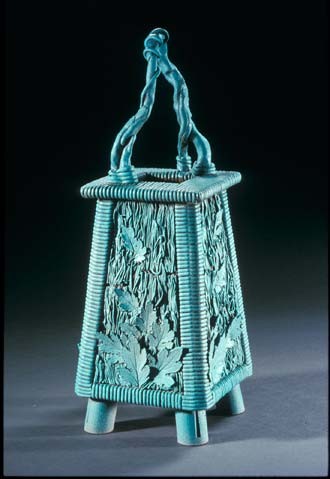Renowned potter Shuji Ikeda has learned to let go of ego and anger
| Shuji Ikeda employs delicate strands of clay to mimic the texture of straw. |
"You have to push and bend at the same time; if you just bend, the clay will break!" Award-winning potter Shuji Ikeda is standing in the center of the Southwest School of Art & Craft pottery studio with a worm of freshly extruded clay in his hand. It's late afternoon and his students have been at work since 7 in the morning. Some squint back at him over Styrofoam cups of coffee, others quietly continue working. "You have to memorize the character of the clay through your skin, you have to touch the piece," Ikeda adds.
He wasn't always this sage.
Ikeda came to the U.S. from Okiyama, Japan in 1973 to study film at San Francisco State University. A good student, he assumed that, like the universities in Japan, SF State would have a list of employers eager to hire him upon graduation. Instead, the career counselor told him, "'You go knock on doors and say how great and hardworking you are,'" Ikeda says, "I couldn't do that; it felt like lying. And I was very depressed. For the first time I felt the temperature of the water of the world."
Serendipitously, a clay studio opened down the street, and Ikeda enrolled in classes to assuage his broken creativity. Soon, what began as therapy became a living. "It just kind of took off," he says, "I liked it. I didn't have to speak a lot of English, I just show people the work. If they liked it, they bought it."
| In March, Ikeda taught potters at the Southwest School of Art & Craft how to make the baskets in a three-day workshop. |
Theoretically, cups will break in the kiln twice as often as bowls because they have two pieces. Ikeda decided to craft a woven ceramic basket made from 300-500 pieces, primarily delicate strands of clay, woven and wrapped around a heavy slab base. The strands create the illusion of a straw basket, but they also hold the vessel together. "It's supposed to break 500 times more," he laughs. "So it should not be possible, but that's what I was trying to do." It took him three years to build a basket - what he calls a "heartbreaking" period of learning - that emerged from the kiln whole. "I thought I knew everything about clay, but that wasn't so," he admits of the process.
Ironically, after all that work to create something so complex it couldn't be duplicated, these are the very baskets he is teaching the students at SSAC to build.
At almost the same time he found commercial success with his baskets, Ikeda had an epiphany. He met a young, single mother at a San Francisco craft fair selling raku pots, glazed with his formula. "I realized I was wrong; what she did was great, very responsible," he says. "She was making a living with clay, under such circumstances - being a single mother is very difficult - and the idea that my knowledge had somehow helped her made me feel human."
| |
Ikeda, who also teaches the Buddhist flower arranging practice Ikebana, weaves elements of philosophy through his teachings. "We can't save happiness, we just have to use it," he says. It's an ongoing lesson. In the SSAC pottery studio, the students are hopelessly behind. The baskets take five days to make and they have only three. Shuji moves calmly among them, taking a few students several steps ahead so that they can help the others finish after he leaves.
In an earlier lecture, Ikeda presented a vase he glazed to resemble the course of water as it cascades off rock. The students, floored by its beautiful earthiness, asked if they could have the glaze. "Maybe if I get a little healthier," Ikeda answered wryly. "I'm still struggling with that." •
By Susan Pagani




